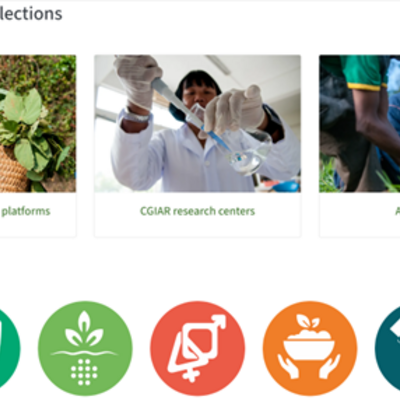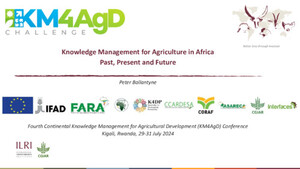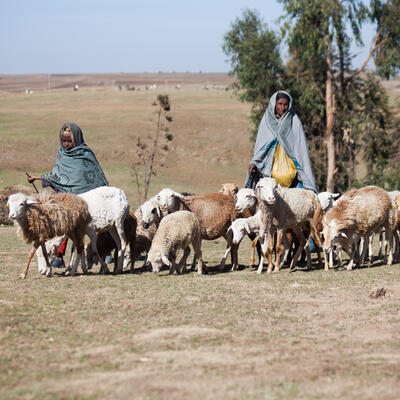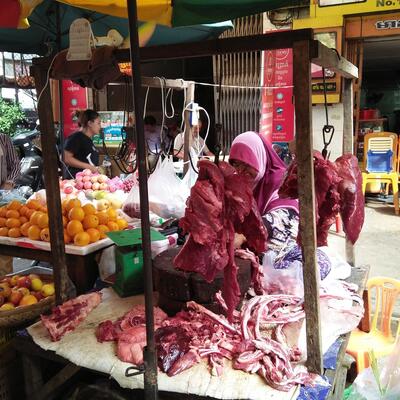
Livestock story-telling at ILRI—Part 2: Ekta Patel, Maasai ‘Fly Girl’

Ekta Patel (photo credit: ILRI/Paul Karaimu).
The 2019 institutional program meeting of the International Livestock Research Institute (ILRI), which was held under a large tent on ILRI’s handsome Addis Ababa, Ethiopia, campus last Sep, tried out something new. Nine staff members were asked to present a brief personal story to the 200 ILRI staff assembled about how they were helping ILRI to achieve one of its five ‘critical success factors’: (1) get the science right, (2) influence decision-makers, (3) grow capacity, (4) secure sustainable and appropriate funding and (5) ensure ILRI is fit for purpose.
This was Ekta Patel’s story.
***
My name is Ekta Patel. I’m communications manager for ILRI’s Bioscience Directorate.
I’m an unusual species. I come from an Indian background, but while most Indians in East Africa go into business, I had a passion for molecular biology and became a scientist. For nearly ten years, I worked in the lab. Like many of you here today, I would get excited when I went to check if there was a band on my gel or if I had managed to get my cells infected.
While creating bacterial mutants to better understand drug resistance, I couldn’t sleep at night I was so excited to get into the lab the next day to check if my transfections had worked. Years passed this way!
Then one day my supervisor, Phil Toye, asked me to join some vets in the field to deliver the vaccine we had made here at ILRI for the cattle disease known as East Coast fever. This prospect did not excite me; what was a molecular biologist going to do in the field? Honestly, I thought, I belong in the lab, with my pipettes where I had convinced myself that I might make magic happen.
But I went. And nothing has been the same since.
We took a four-and-a-half-hour drive from Nairobi, Kenya, to northern Tanzania, staying the night in the town of Arusha. Before daybreak the following morning, we drove another hour to reach a remote Masaai village in Monduli. A cold dawn was breaking over vast, bare plains. The Maasai men, women and children appearing out of their traditional low, mud-walled homes, wearing only their traditional garments, also looked cold in the early morning.
At a manyatta (homestead), we were welcomed and offered some ‘special’ Maasai tea that a woman was pouring into plastic cups from a traditional milk gourd. The drink did not smell like tea and it did not look like tea. Freaking out a bit, I wondered to myself if the milk was mixed with cattle blood, like I’d heard was a Maasai tradition. I appreciated the offer of tea but thought, ‘No thank you!’
After watching my colleagues drink the Maasai tea without dying, I made myself take a gulp and then looked for somewhere to pour out the rest.
Fortunately for me, I didn’t have to finish the drink as the cattle were then gathering from the nearby villages and the first streaks of sun rays were appearing. It was time to get to work vaccinating the cattle.
I was excited thinking that we would soon be done with our work and could go home. As we got closer to the animals in the Maasai boma (livestock enclosure), we smelled the damp soil mixed with cattle faeces and were accosted by many flies. The flies landed on my pen and on my book and on my face. I waved my hands to shoo them away. I saw flies resting on the women sitting nearby and on the children playing. I watched as flies covered a baby’s face, it’s nose and eyes. With my background in microbiology, I couldn’t help thinking about all the germs the flies could pass to the baby.
All the pictures I ever saw in National Geographic were all here, raw and live.
Hours later, as we wrapped up our work, the Maasai men, who usually eat separately from the women, invited me as well as my male colleagues to sit in their circle and eat with them. This was an honour; it was their way of showing their gratitude for the vaccine that we had brought for their precious animals. A few minutes later, a young Maasai boy brought to the circle the whole leg of some animal that had been roasted on a stick. He stabbed the earth in the middle of our circle with the meat stick so that everyone could share the meat. My thoughts were running away with me.
I’m in the habit of eating chicken curry, not meat from an animal that I don’t know, roasted I don’t know how, and stuck on a stick in the dusty earth!
Our translator, seeing my discomfort, asked me what was wrong. How was I to explain that I was completely out of my comfort zone?
I went back to Monduli a few more times after this. On my next trip I brought some non-toxic fly traps and showed community members them how to use them. The fly traps worked like magic for them, and I earned a nick name—‘msichana inzi’, ‘fly girl’.
Having found a solution to one of their problems, one of the village women invited me into her tiny mud hut. Reluctantly, I bent down low and followed her through the small doorway—the hut was dark inside and smelt of cow dung. The woman showed me where she and her family slept—on a stiff slab of dried cow dung raised to the height of a bed on which they would place a sheet. She showed this to me because she wanted to know if I had something that would stop bugs of some kind from biting their scalps. It was too dark for me to see if there were any bugs on the dung bed and I’m ashamed to say that I couldn’t wait to dash out of her hut, thinking of the lice, or ticks or mites that might get into my head!
I didn’t help that Maasai woman. I felt totally inadequate in her environment. After that, I began taking a hard look at my inflexibilities, along with all my textbook knowledge, compared to what these pastoralist communities really needed. How was I as a scientist supposed to make a difference to these people and their livestock when I wasn’t able to take the opportunity to understand their needs?
I wanted things to change for these Maasai for the better. But I understood that I had to change first.
Most of you would say that, serving ILRI now as a communications staff rather than a scientist, that my main job is to influence decision-makers. But that’s not how I see it.
The ILRI critical success factor I’m working on most is ‘getting the science right’. Because without communications, the science can’t get right.
For those of us fortunate enough to spend part or all of our lives on the African continent—we need to understand its harsh realities as well as its rich resources. I look forward to working with all the scientists and all the non-scientists of this institute and directly with the many people our research serves—to get our science right.
And these days I look forward to drinking more of that special Maasai tea.
Read Part 1 of this series: Livestock story-telling at ILRI—Part 1: Introduction, ‘Descending into the particular’, 9 Jan 2019.
Watch a video of Ekta Patel making this presentation.



















